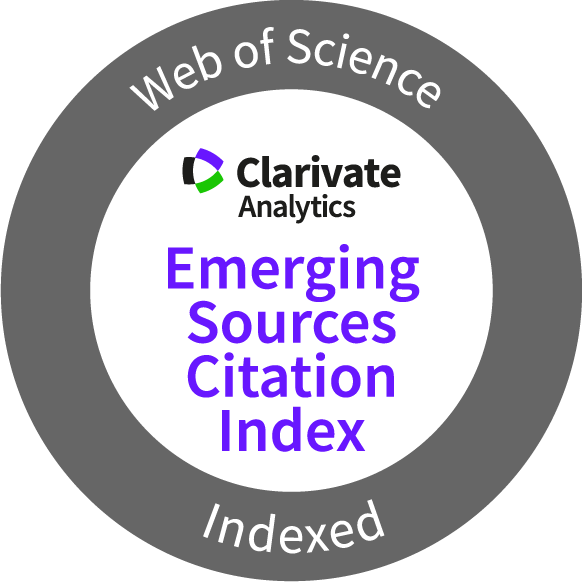Chemistry Journal of Moldova
Inorganic and coordination chemistry
Author(s):
Field: Inorganic and coordination chemistry
Type: Research paper
Issue: 2018 Volume 13, no.1
Pages: 54-62
Nataliia Kariaka, Olena Litsis, Yuriy Kolomzarov, Paula Gawryszewska, Sergii Smola, Nataliia Rusakova, Victor Trush, Tatiana Sliva, Vladimir Amirkhanov
Field: Inorganic and coordination chemistry
Type: Research paper
Issue: 2018 Volume 13, no.1
Pages: 54-62
Full Text (PDF): Download
Abstract (PDF)
Graphical Abstract: The lanthanides coordination compounds LnL3, LnL3Phen and LnL3Dipy with bulky aryl-functionalised carbacylamidophosphate (CAPh) ligand N-(diphenylphosphoryl)benzamide (HL=PhC(O)N(H)P(O)Ph2) were synthesized for luminescent thin films producing. The films were obtained by vacuum evaporation and spin coating methods and exhibited intensive monochromatic photoemission with decay times equal to 0.78 1.34 ms.
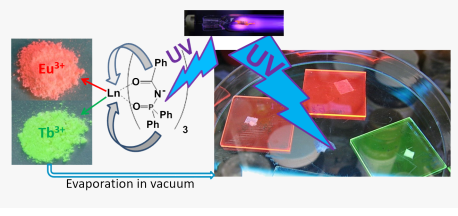
Graphical Abstract: The lanthanides coordination compounds LnL3, LnL3Phen and LnL3Dipy with bulky aryl-functionalised carbacylamidophosphate (CAPh) ligand N-(diphenylphosphoryl)benzamide (HL=PhC(O)N(H)P(O)Ph2) were synthesized for luminescent thin films producing. The films were obtained by vacuum evaporation and spin coating methods and exhibited intensive monochromatic photoemission with decay times equal to 0.78 1.34 ms.

Downloads: 277
Author(s):
Field: Inorganic and coordination chemistry
Type: Research paper
Issue: 2018 Volume 13, no.1
Pages: 46-53
Viorina Gorinchoy, Vera Zubareva, Elena Melnic, Victor Kravtsov
Field: Inorganic and coordination chemistry
Type: Research paper
Issue: 2018 Volume 13, no.1
Pages: 46-53
Full Text (PDF): Download
Abstract (PDF)
Graphical Abstract: The reaction between iron and nickel salts with ammonium salicylate results in the formation of a new trinuclear heterometallic complex
Graphical Abstract: The reaction between iron and nickel salts with ammonium salicylate results in the formation of a new trinuclear heterometallic complex
[hexa-µ2-salicylato-µ3-oxo-(methanol)(dimethylformamide) aquadiiron(III) nickel(II)] methanol dimethylformamide. The synthesized [Fe2NiO(SalH)6(CH3OH)(DMF)(H2O)]•DMF•CH3OH complex crystallizes in the monoclinic space group C2/c. The IR and Mössbauer spectra and thermal properties were studied.

Downloads: 175
Author(s):
Field: Inorganic and coordination chemistry
Type: Research paper
Issue: 2018 Volume 13, no.1
Pages: 36-45
Lidia Cuba, Paulina Bourosh, Victor Kravtsov, Elena Gorincioi, Diana Dragancea
Field: Inorganic and coordination chemistry
Type: Research paper
Issue: 2018 Volume 13, no.1
Pages: 36-45
Full Text (PDF): Download
Graphical Abstract: Two vanadium(V) complexes comprising VO3+ and VO2+ cores with o-vanillin semicarbazone (H2L) have been synthesized and characterized by IR, NMR spectroscopies and single-crystal X-ray diffraction study. The coordination polyhedra are a O5N distorted octahedron in the mono-oxidovanadium complex [VO(HL)(EtO)(EtOH)0.6(H2O)0.4][VO(HL)(SO4)(EtO)]•0.4EtOH (1) and a O4N square-pyramid in the dioxidovanadium compound [VO2(HL)]•2H2O (2).
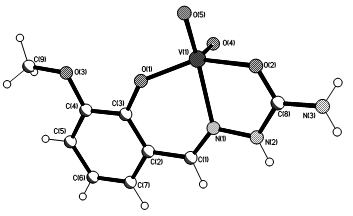

Downloads: 136
Author(s):
Field: Inorganic and coordination chemistry
Type: Research paper
Issue: 2018 Volume 13, no.1
Pages: 30-35
Aliona Vitiu, Lilia Croitor, Anatolii Siminel, Eduard Coropceanu, Paulina Bourosh
Field: Inorganic and coordination chemistry
Type: Research paper
Issue: 2018 Volume 13, no.1
Pages: 30-35
Full Text (PDF): Download
Graphical Abstract: A new two dimensional 2,2′-bipyridine-4,4′-dicarboxylate Zn(II) coordination polymer was obtained by hydrothermal synthesis and characterized by IR spectrum and single-crystal X-ray diffraction. The crystal lattice hosts the N,N-dimethylformamide and water solvent molecules. The new material reveals blue-orange luminescence upon excitation with ultraviolet light.
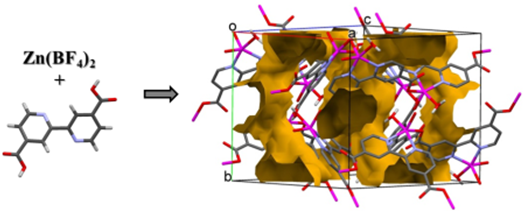

Downloads: 136
Author(s):
Field: Inorganic and coordination chemistry
Type: Research paper
Issue: 2018 Volume 13, no.1
Pages: 24-29
Natalia Terenti, Marilena Ferbinteanu, Ana Lazarescu
Field: Inorganic and coordination chemistry
Type: Research paper
Issue: 2018 Volume 13, no.1
Pages: 24-29
Full Text (PDF): Download
DOI: http://dx.doi.org/10.19261/cjm.2017.371
Abstract (PDF)
Supplementary Material (PDF)
Graphical Abstract: A new Co(III) complex [CoIII(2,3-pdcH)3(H2O)3] (2,3-pdcH – monoanion of 2,3-pyridinedicarboxylic acid) has been synthesized from Co(II) salt at room temperature by using nonhydrothermal method and (NH4)2S2O8 as oxidant. The influence of the type of Co(II) salt used to the synthesis of the final product was investigated. The complex was characterized by elemental analyses, IR and UV-VIS spectroscopy, single crystal X-Ray diffraction and thermogravimetric analyses. The complex crystallizes in the monoclinic space group P21/c. The crystal structure reveals a homoleptic complex with a distorted octahedral geometry, where the ligand acts as monodeprotonated N, O-chelating anion.
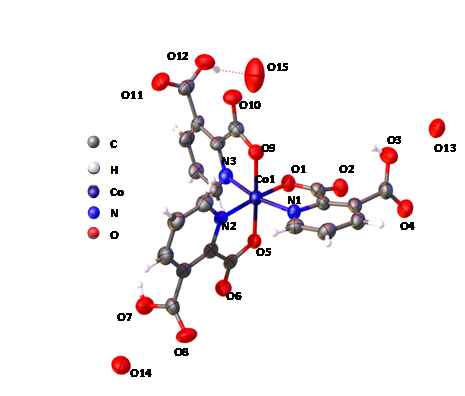

Downloads: 125
Author(s):
Field: Inorganic and coordination chemistry
Type: Research paper
Issue: 2018 Volume 13, no.1
Pages: 15-23
Olena Litsis, Vladimir Ovchynnikov, Tatiana Sliva, Svitlana Shishkina, Vladimir Amirkhanov
Field: Inorganic and coordination chemistry
Type: Research paper
Issue: 2018 Volume 13, no.1
Pages: 15-23
Full Text (PDF): Download
Abstract (PDF)
Graphical Abstract: New mononuclear six-coordinate lanthanide coordination compounds [Ln (HL)3Cl3] (HL = (2,2,2-trichloro-N-(dipiperidin-1-yl-phosphoryl)acetamideCCl3C(O)N(H)P(O)[N(CH2)5]2, carbacylamidophosphate (CAPh) type ligand) have been synthesized from non-aqueous solutions. The complexes have been characterized by elemental analysis, spectroscopic methods (FTIR, 1H- and 31P-NMR, UV-Vis). The structure of [Sm(HL)3Cl3] has been further confirmed by single crystal X-ray diffraction analysis.

Graphical Abstract: New mononuclear six-coordinate lanthanide coordination compounds [Ln (HL)3Cl3] (HL = (2,2,2-trichloro-N-(dipiperidin-1-yl-phosphoryl)acetamideCCl3C(O)N(H)P(O)[N(CH2)5]2, carbacylamidophosphate (CAPh) type ligand) have been synthesized from non-aqueous solutions. The complexes have been characterized by elemental analysis, spectroscopic methods (FTIR, 1H- and 31P-NMR, UV-Vis). The structure of [Sm(HL)3Cl3] has been further confirmed by single crystal X-ray diffraction analysis.

Downloads: 225
Author(s):
Field: Inorganic and coordination chemistry
Type: Research paper
Issue: 2017 Volume 12, no.2
Pages: 41-49
Felix Sunday Nworie, Frank Ikenna Nwabue
Field: Inorganic and coordination chemistry
Type: Research paper
Issue: 2017 Volume 12, no.2
Pages: 41-49
Full Text (PDF): Download
Abstract (PDF)
Graphical Abstract: A new synthetic extractive protocol for the synthesis of Cu(II) and Co(III) complexes of bis(2,2/-methylylidenephenol)diaminoethane (H2BMPDE) in a single simple step was performed. The obtained data indicated the formation of complexes with 1:1 molar ratio of metal:ligand, of distorted square planar and distorted octahedral geometries. In vitro antibacterial screening revealed that the complexes were active against clinically important gram-negative bacteria (Escherichia coli, pseudomonas, and gram-positive bacterium (Staphylococcus aureus). The synthesis of the complexes was optimized to make it more suitable and efficient for industrial scale production.

Graphical Abstract: A new synthetic extractive protocol for the synthesis of Cu(II) and Co(III) complexes of bis(2,2/-methylylidenephenol)diaminoethane (H2BMPDE) in a single simple step was performed. The obtained data indicated the formation of complexes with 1:1 molar ratio of metal:ligand, of distorted square planar and distorted octahedral geometries. In vitro antibacterial screening revealed that the complexes were active against clinically important gram-negative bacteria (Escherichia coli, pseudomonas, and gram-positive bacterium (Staphylococcus aureus). The synthesis of the complexes was optimized to make it more suitable and efficient for industrial scale production.

Downloads: 82
Author(s):
Field: Inorganic and coordination chemistry
Type: Research paper
Issue: 2017 Volume 12, no.2
Pages: 34-40
Masahiro Mikuriya, Iyo Matsushima, Daisuke Yoshioka
Field: Inorganic and coordination chemistry
Type: Research paper
Issue: 2017 Volume 12, no.2
Pages: 34-40
Full Text (PDF): Download
Abstract (PDF)
Graphical Abstract: Mixed-valent trinuclear manganese complex with N,N’-bis(2-hydroxy-3,5-dimethylbenzyl-N,N’-dimethyl-1,2-ethanediamine (H2hdde), [Mn3(hdde)2(CH3CO2)2(CH3O)2], was synthesized. The X-ray crystal structure analysis revealed a linearly arrangement of MnIII-MnII-MnIIIcore, where a ferromagnetic coupling (J = 2.62 cm–1) between the MnIII and MnII ions.
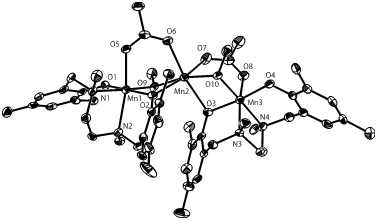
Graphical Abstract: Mixed-valent trinuclear manganese complex with N,N’-bis(2-hydroxy-3,5-dimethylbenzyl-N,N’-dimethyl-1,2-ethanediamine (H2hdde), [Mn3(hdde)2(CH3CO2)2(CH3O)2], was synthesized. The X-ray crystal structure analysis revealed a linearly arrangement of MnIII-MnII-MnIIIcore, where a ferromagnetic coupling (J = 2.62 cm–1) between the MnIII and MnII ions.

Downloads: 60
Author(s):
Field: Inorganic and coordination chemistry
Type: Research paper
Issue: 2017 Volume 12, no.2
Pages: 28-33
Inna Seifullina, Elena Martsinko, Elena Chebanenko, Eleonora Afanasenko, Viktoriya Dyakonenko, Svitlana Shishkina
Field: Inorganic and coordination chemistry
Type: Research paper
Issue: 2017 Volume 12, no.2
Pages: 28-33
Full Text (PDF): Download
DOI: dx.doi.org/10.19261/cjm.2016.369
Abstract (PDF)
Graphical Abstract: Two crystalline compounds of germanium(IV) with malic acid (HMal) and 1,10ʹ-phenanthroline (phen) - [Ge(HMal)2(phen)]•pheh•2H2O (I) and [CuCl(phen)2][Ge(OH)(HMal)2] (II) were synthesized for the first time and characterized by elemental analysis, IR-spectroscopy and thermogravimetric analysis. There was elucidated from single-crystal X-ray diffraction that two different forms of Germanium are implemented: Ge4+ (I) and hydrolyzed GeOH3+ (II) to form distorted octahedron and pyramid respectively.
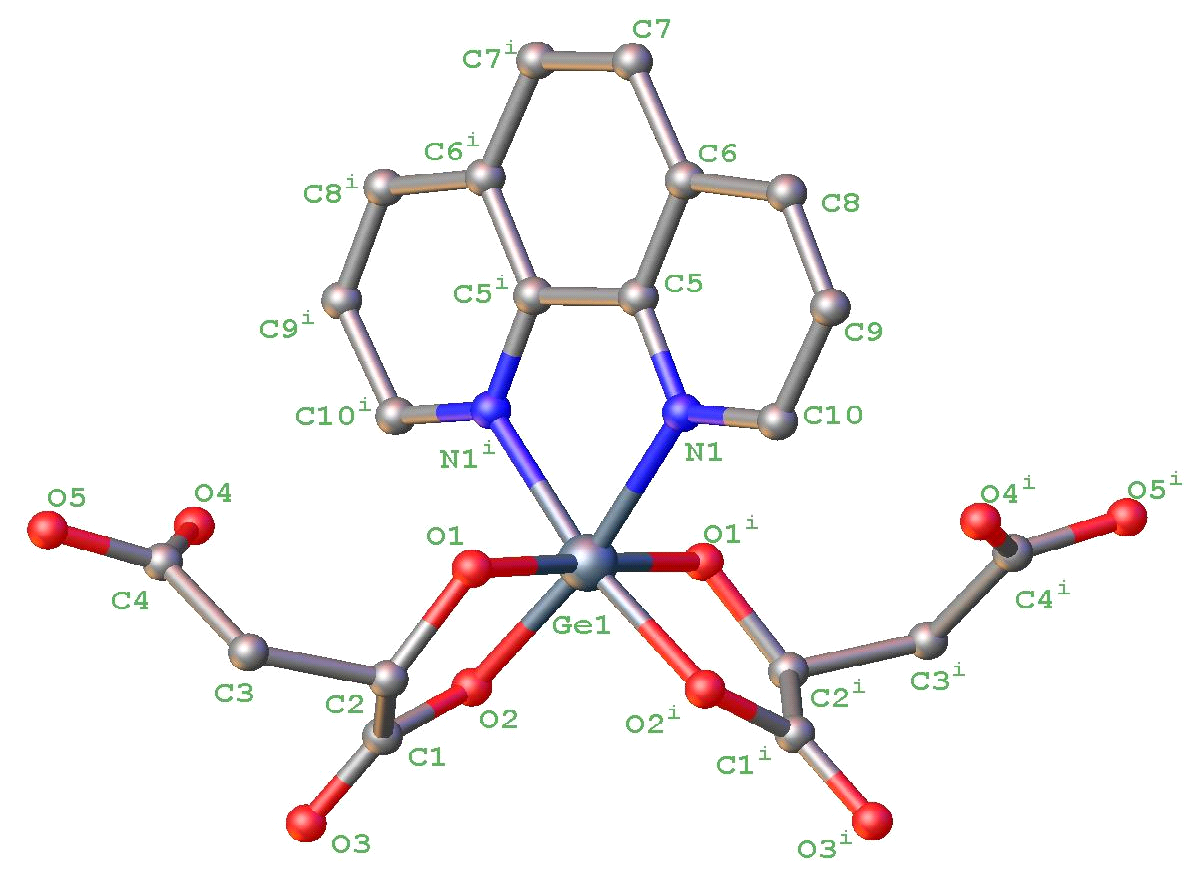
Downloads: 105
Author(s):
Field: Inorganic and coordination chemistry
Type: Research paper
Issue: 2017 Volume 12, no.1
Pages: 74-80
Olesea Cuzan
Field: Inorganic and coordination chemistry
Type: Research paper
Issue: 2017 Volume 12, no.1
Pages: 74-80
Full Text (PDF): Download
DOI: dx.doi.org/10.19261/cjm.2016.370
Abstract (PDF)
Graphical Abstract: The novel N-(methylene-2-pyridine)-N,N-bis(diethoxyphosphorylmethyl)amine ligand (L) was obtained through a double Kabachnik-Fields reaction, starting from 2-aminomethyl pyridine (2-picolylamine). Based on the L ligand, a new palladium(II) coordination compound [Pd(L)2Cl2] has been synthetized and comprehensively characterized by spectroscopic methods (1H NMR, UV-Vis), ESI mass spectrometry and X-ray crystallography.
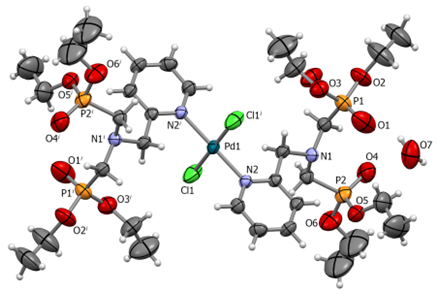
Downloads: 115


